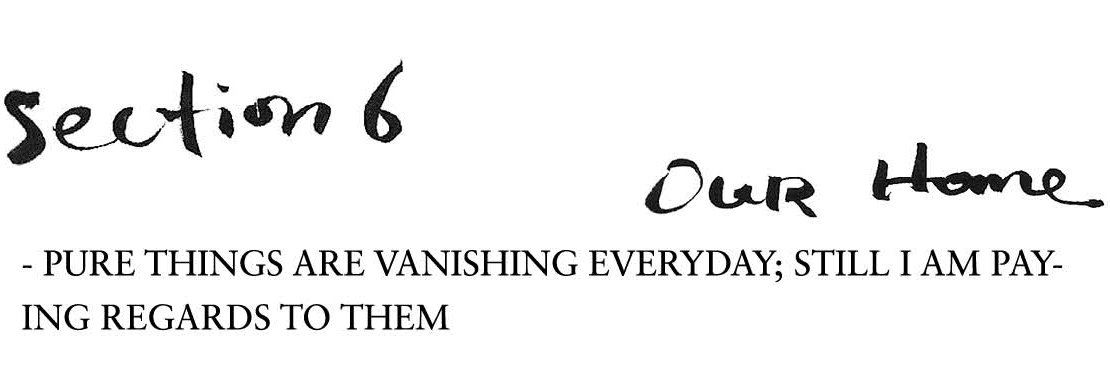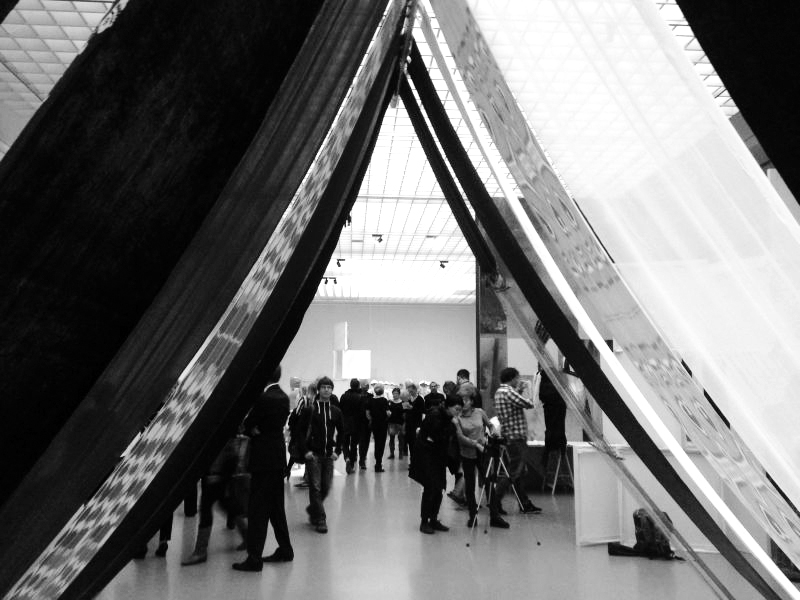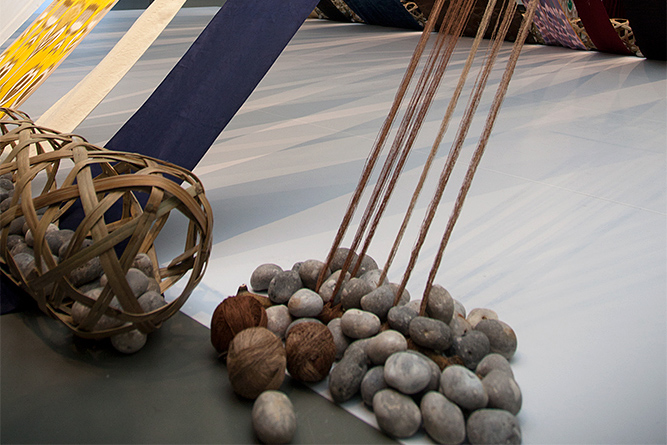



我们的家园
- 纯然之物日渐消逝,谨守护之
这次的展览概念来自于我个人对目前世界的疑问:“现代技术主导下的人类进化史会发生什么样的质变,我们是否还有更合适的进化方向?”
现代社会,所有事物的发展,皆以经济效益为前提与原则,导致大量人类社会沿用了几百甚至是上千年的习惯在极短时间内一一被推翻。我们的生活有了更多的刺激和“可能性”,但这并不表明我们精神上会更加富有,反而是埋下了不少潜在的危险。如果以中国古人的思考方式来观现世之貌,经济上的迅猛发展并没有解决人与自然和谐共存的问题,我们现在取得的进步,反而更像是在退化。借用一本“后现代主义”概念的主要创造者齐格蒙·鲍曼 Zygmunt Bauman 的书名“现代性与大屠杀” (Modernity and the Holocaust) 来描述近一个世纪世界发展的状态,或许是恰当的。
从去年开始,我对服装材料的研究重心转向了原始的手工面料。这次展览的系列作品选用了几种产于中国特定地区,传继了当地古法所制的面料。这些面料被当地人作为重要的生活用品和族系标识,据考古所证,有些甚至超过了3000年——分别是海南岛黎锦,贵州苗侗牛血亮布,西藏山南氆氇,新疆和田艾德莱丝绸,广东南海区香云纱,江苏南通蓝印花布,四川荣昌夏布,河南南阳柞蚕丝… 它们中有源自中国的蚕丝、苎麻,亦有在历史上融入中华文明的边疆民族的棉和羊毛。它们是人类生活中最重要的几种天然纤维,先民们发明了各种与之匹配的纺纱织布法,并掌握了用植物与矿物等天然材料做印染,以此为庇,栖于自然。这些面料的发展史,映射了整个古代人类社会物质与精神文明的演进——古代世界正是凭人们一砖一瓦一针一线,以手工劳作搭建起来的,迥异于现代社会所崇尚的以机械生产为主力的复制行为;在古人千百次重复的手作中,饱含了现代工业中已然丧失的自然之力——这即是我想要转换给现代社会的能量。
以这些传统面料搭建出人类最原始的住屋形态——帐篷,是为连接过去与未来,它们共同呈现的“现在”,在我看来,才是人们真正期愿的时尚。因为时尚不论在何时,都是在展现人们认真生活的每一个当下——当下的欲望,当下的喜乐……
服装因时而尚,而“做衣服”这件事,确是千古不易。现代的织造工具与古时相较,原理几乎没有改变,古时候的人们凭借简单的工具,仅靠双手就能做出许多现代机器力所不能及的事物。古时的“桑麻遍野,户户机杼”,家园的建造者和使用者是同一个人;而在现代技术的急速更替与经济利益的驱动下,人们不再织布、制器以自用,所谓“家园”,已然变为消费社会里的滥觞。“在千篇一律的技术文明世界里,是否还有,如何能再有真正的家园?”我的回答是:“谨守护我们的家园。”

精诚所至,金石为开
- 荷兰的堤岸
荷兰是一个以填海造陆知名的国家,有说荷兰人填入海的石头与中国建起长城用的石头一样多。从十三世纪开始,荷兰土地面积因海水侵蚀减少了56万公顷。为此,荷兰一直在同大海进行斗争,经过几个世纪的努力,建成堤坝的总长度己达1800公里,向大海索回了70万公顷的土地。而其中由荷兰著名水利工程师设计的拦海大坝可以称为是近代人类的一个伟大工程。在中国亦被称赞作“精卫填海”工程。

荷兰须德海围海造地大坝——阿夫鲁戴克大堤 Afsluitdijk,是荷兰近代最大的围海工程。1932年,荷兰人民筑起宽90米,湾内岸线300公里,高出海面7米的拦海大堤,把须德海湾与北海大洋隔开。

都江堰地区流传千年的治水方法,是用杩槎、卵石、竹笼、碗儿兜等工具,就地取材,来为河流截流清淤。人们先以土石做基,再以卵石填充竹笼护堤,都江堰两千多年来一直发挥着防洪灌溉的作用,使成都平原成为水旱从人、沃野千里的"天府之国",至今灌区已达30余县市、面积近千万亩,是全世界迄今为止,年代最久、唯一留存、以无坝引水为特征的宏大水利工程。
这次的展览的主体是一个帐篷,两侧需要用重物固定。想到荷兰人填海的伟大壮举,可以想象“家园”对荷兰人意味着什么——700多年,未中断的,用石料向海洋要回被其侵蚀的土地。而中国与荷兰一样,几千年来亦从未停止过与水的斗争,从上古的大禹治水到公元前250年蜀郡太守李冰父子所建造的都江堰,人们以自己的勤劳与智慧换取了更美好的生活家园。用荷兰人守护家园的石头参与进这个来自遥远东方大陆国家的,同样以守护家园为主题的作品,若按中国人的说法,只道是水到渠成。

后记
由于时间与我个人精力之限,涉猎不甚广泛,只及中国大陆部分地区,亦只能撷取当地现存的传统材料为这次展览所用。在未来不短的时间内,我将继续深入研究东方服饰在当代语境下的呈现,去追溯不仅仅是中国,包括世界各古老民族的生存记忆与生活方式,以此作为设计与制衣的基础。
Our Home
- Pure things are vanishing everyday; still I am paying regards to them
This exhibition concept stems from the doubts that arise from the narrative “Modern technology is the power to accelerate civilisation progress.”I am asking if there is another direction for evolution or a more sustainable path to follow.
The leading direction of modern society revolution relies on industrial economic principle, so that many traditional customs that do not serve the economic benefits have faded in recent years. There are more and more stimulus and possibilities getting into our life, but this does not mean we are becoming richer in spiritual life, in contrast, we unconsciously stepping on the thin ice with hidden danger. The rapid economic and technologic development does not provide us answers to sustainability. Is our modern achievement an evolution or degeneration? Referring to Zygmunt Bauman’s book Modernity and the Holocaust, in order to picture the progress of this century’s evolution it might be appropriate to examine the concept of modernity.
I decided on several fabrics that are present only in certain areas of China in order to demonstrate the traditional production techniques in the exhibition after I finished my research. According to archaeological study, these fabrics have a long history running from 1000 to 3000 years and are believed to have served as important identity symbols and household goods in the lives of local people. —— Li brocade from Hainan Island; Miao/Hmong sheen cloth from Guizhou; Summer cloth from Rongchang, Sichuan; Pulu wool from South Tibet; Atlas silk from Hotan, Xinjiang; Canton gauze from Nanhai, Guangdong; Blue cloth from Nantong, Jiangsu, and Tussah silk from Nanyang, Henan. Some of these come from mainland China, like silk and ramie, while some combine Chinese textile culture with ethnic minority people, like Tibet wool and Li cotton. Tent is the oldest way to build a shelter. The idea of “Our Home” is to awake the life experience in our deep memory, and to build a bridge between the past and the future. I believe our life experience would be the best inspiration for fashion.
The range of fabrics I chosen contain most natural fibres, dyeing technology and weaving technology that I leant from tradition. Textile development is an excellent reflection on the evolution of human society. Studying traditional fabric-making shows us the old spirit we have lost in modern industrial age.
Fashion always presents everyday life of our times. The principle of modern waving machine and old waving machine is the same. In the past, people just used their hands and simple tools to build their home, but now we do not build our home on our own hands anymore. “Home” this word has became a cliché of consumerism. “In the machine-made modern civilisation, how can we have our home, and how can we build our home? ” To the question of whether there is another leading direction for evolution, or a more sustainable way to go, my answer is: just to regard our home.

The theme of this commission is a tent that needs to be fixed on two sides by weight. Thinking of the Dutch people’s great achievement, I can imagine what “home” means to you. For 700 years, you constantly to filling the sea with stone, and it is similar for the Chinese people, we never stop to fight to the flood disaster. From the King Yu’ flood control to Li Bing’ Dujiang Dam, we used our intelligence to fight for a better life. Thus, I think this is important to get the Dutch people involved in this project. The stones from the Netherlands and the tent from the remote Eastern nation China will work together to reflect the same spirit of protecting our home as a Chinese saying: when water flows, the channel is formed.
Postscript
Text - Dooling Jiang Translation - Hooh Cheung
Nothing is impossible for a faithful heart, faith moves mountains
- The Netherlands’ embankment
The Netherlands is a nation famous for reclaiming the land from sea. I’ve heard a story that the amount of stones that the Dutch people have taken for filling the sea is as many as the Great Wall’s. Since the 13rd century, the seawater eroded the national territory of The Netherlands; therefore, The Dutch people started a war against the sea erosion for several centuries. Now the nation has an 1800km long embankment reclaiming 560,0000ha from the sea. It is a great achievement in the global history. Chinese people even praise it is like Jingwei Filling the Sea, which is a symbol of dogged determination in China.

Due to the limited time frame my studying only covers certain areas in Mainland China for this exhibition. In the next, I will go on to study how the traditional dress culture could revive in the modern context in the world but not only in China.
post date: 2014/11/10